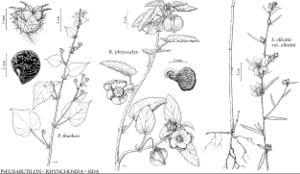Difference between revisions of "Pseudabutilon thurberi"
Contr. Univ. Michigan Herb. 21: 189. 1997.
FNA>Volume Importer |
imported>Volume Importer |
||
| (One intermediate revision by the same user not shown) | |||
| Line 61: | Line 61: | ||
|publication year=1997 | |publication year=1997 | ||
|special status=Conservation concern;Illustrated | |special status=Conservation concern;Illustrated | ||
| − | |source xml=https:// | + | |source xml=https://bitbucket.org/aafc-mbb/fna-data-curation/src/2e0870ddd59836b60bcf96646a41e87ea5a5943a/coarse_grained_fna_xml/V6/V6_561.xml |
|subfamily=Malvaceae subfam. Malvoideae | |subfamily=Malvaceae subfam. Malvoideae | ||
|genus=Pseudabutilon | |genus=Pseudabutilon | ||
Latest revision as of 22:22, 5 November 2020
Subshrubs, erect, sometimes decumbent, 1 m, sometimes branching near base and in inflorescence. Stems sparsely setose, hairs spreading, glabrescent, rarely also with few appressed, stellate hairs. Leaves: stipules linear, to 12 × 1 mm, setose; petiole 1/2–1 times blade length, setose; blade ovate, unlobed, to 10 × 6 cm, gradually reduced and narrower upward, apex acuminate, surfaces strigose and stellate-hairy. Inflorescences flowers solitary or paired. Pedicels 0.5–2.5 cm, setose throughout, distally glandular-hairy, sometimes distally stellate-hairy also. Flowers: calyx 4–7 mm, lobes ovate, apex acuminate, setose, glandular and stellate-hairy; petals 4–6 mm, glabrous; staminal column 2–3 mm, glabrous to setose; styles 5-branched. Schizocarps straw colored at maturity, 5–6 mm diam., stellate-hairy; mericarps 5, spur 2–3 mm. Seeds 2–3 mm. 2n = 30.
Phenology: Flowering late summer–fall.
Habitat: Dry, open shrublands
Elevation: 800–1100 m
Distribution

Ariz., Mexico (Sonora).
Discussion
Of conservation concern.
Pseudabutilon thurberi is known only from Pima County.
A taxon from south of our range, Pseudabutilon sonorae Wiggins was placed in synonymy here by P. A. Fryxell (1997b). However, while the two taxa are very similar morphologically, the type illustration of P. sonorae clearly indicates the presence of an endoglossum dividing the carpel into two chambers. This character was not observed in specimens of P. thurberi, which raises uncertainty about the placement in synonymy by Fryxell.
Selected References
None.
